After decades of inaction, Boise might now annex area with 34,000 people. What happened?
The history of city attempts to annex a section of unincorporated Ada County that lies south of West Victory Road into Boise has been long, complicated and contentious. But things were quiet for 13 years until this summer.
Now, annexation of the area known as Southwest Boise has again become a hot topic. Only this time, it’s different from the days when city officials wanted to annex land owned by resistant residents. Now it’s Southwest residents who want annexation, and city officials who aren’t so sure.
Today, many city residents may feel inclined to roll their eyes at people outside Boise limits wanting city services, the ability to vote in city elections and now a 160-acre regional park built by the city — but have always refused annexation. Southwest home owners resisted a change that would require paying higher property taxes. For decades the city could not secure the consent of enough property owners to annex.
As the once-rural area develops at an unprecedented rate, however, many Southwesterners are changing their minds. City amenities like more police, a fire station, and streetlights may soon become essential as developments with thousands of homes are planned. Sixty-three percent of Southwest property owners have legally consented to annexation, according to city data.
The city is now once again considering annexing the entire Southwest area, which consists of 34,000 people living roughly between Cole and Eagle roads, north of Lake Hazel Road and south of Victory Road.
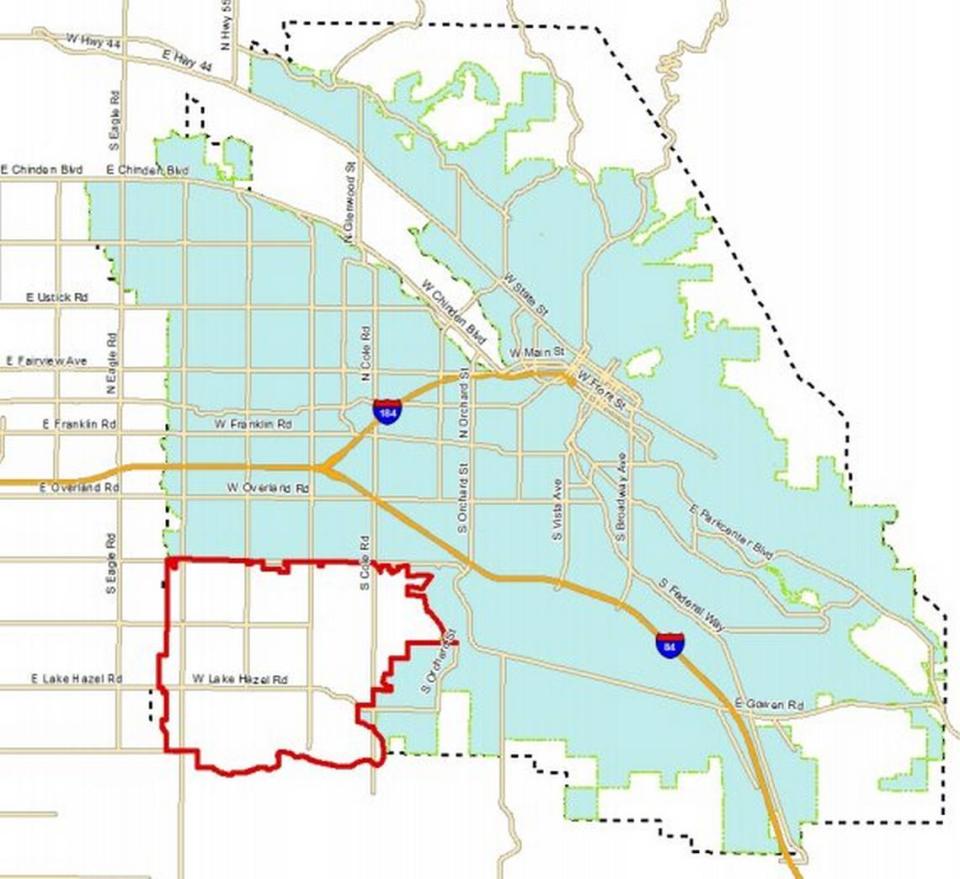
Fight for park reignites annexation discussions
The debate was reignited by a potential land swap. The Harris family, which developed the Harris Ranch planned community in East Boise, has offered Boise 250 acres of land in the Foothills above Harris Ranch in exchange for 160 acres of Southwest land known as the Murgoitio parcel.
Though not within city limits, the Murgoitio (pronounced Mer-GERT-ee-o) parcel is owned by the city of Boise. The parcel is named for the family that sold it to the city, and whose members still farm on it. When the city bought it, the City Council created formal covenants promising to turn it into a regional park.
Residents have been dismayed at the potential loss of the promised park and point to the lack of parkland in the area. Even worse to some is the idea of the housing development the Harris family would build.
What’s more, the Murgoitio family recently asked for another piece of Southwest property that it owns to be annexed. The family want to build a planned community called Murio Farms.
The city hopes the Harris family development would help alleviate Boise’s housing shortage. As part of the deal, the developer would sell homes on the Murgoitio site below the median value.
“I think we need housing, and everybody supports housing,” Kathy Corless, president of the South Cole Neighborhood Association, said in a previous interview about Southwest growth. “But it all can’t be shoved to Southwest Boise.”

Over the last month, the City Council has been taking steps to annex the Murgoitio parcel in anticipation of the land swap. Southwesterners have responded with a slew of opposition efforts. They formed a nonprofit that has hired an attorney, attended a school board meeting to urge trustees to support their efforts, picketed City Hall and lined up local children at Peppermint Park’s lone swing set to show the lack of Southwest park space. They enlisted former NFL wide receiver Terrell Owens, who is not from Boise, to urge city officials to “live up to your promise” and build the park.
Many of the protesters would like to be annexed, especially if it means stopping the trading or selling of the park site. Their efforts have led to the council considering annexing the entire Southwest area rather than just Murgoitio.
“I’d be happy to pay (higher taxes) if it meant getting that park,” said Southwest resident Rachael Grotsky.
Many Boiseans have become sympathetic as they learn more about the issue. Council Member Lisa Sánchez saw the rendering of Murgoitio Park created by the city for the first time at a Boise City Council meeting Tuesday, July 13. Older residents recall voting on park features, and some newer residents were given the park drawing by real estate agents when looking at houses near the site.
“When I kept hearing, ‘We were promised a park, we were promised a park,’ I didn’t understand,” Sánchez said. “But to have it down on pen and paper and have that visualization, I am starting to understand why folks are so upset.”
Other officials have said it’s not the city’s job to provide amenities like the park to non-city residents.
“They’re not paying for the development of the park, and they’re not paying for the maintenance of the park,” Boise Parks and Recreation Director Doug Holloway said in a phone interview. “That’s paid for by the residents inside the city limits. … It would be like developing a park for Kuna. Whether you live 100 feet from it or you live 10 miles from it, you don’t pay city taxes to support that park.”
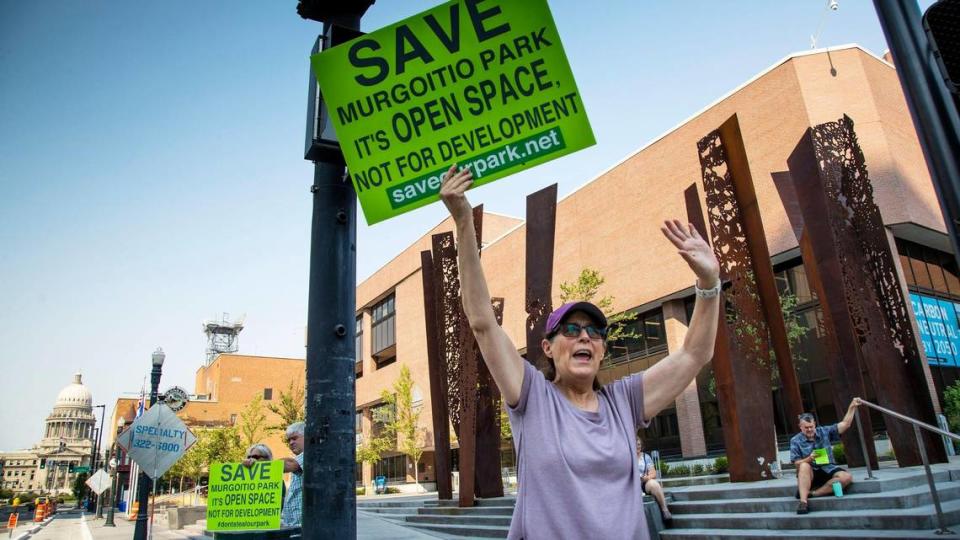
Why hasn’t the Southwest been annexed?
The history of proposed Southwest annexation began in the 1970s. The Southwest was expanding rapidly. Septic tanks were being placed on “lots smaller than we would ever allow today,” said Jennifer Tomlinson, Parks and Recreation Department superintendent, in a presentation to the council about the impacts of bringing the area into the city.
Tomlinson previously worked as the city’s associate comprehensive planner for seven years.
More than 6,000 homes were on septic tanks, many on lots just a quarter of an acre in size, she said. Some tanks became contaminated. In later decades, two septic tanks would fail altogether, leaving communities without a way to deal with their sewage. Ada County placed a moratorium on development.
Neither the city nor the county were pleased at the halting of growth. In 1978, the city added the Southwest to its area of impact, a designation under state law that means the city expected to annex it at some point.
The county asked the city to add the area to Boise’s sewer system. The city agreed. Boise would go on to spend more than $10 million in sewer extensions for 15,000 to 20,000 unincorporated residents by 2005. The residents are required to pay sewer service fees.
The city, having spent so much money, wanted to annex. The City Council decided that anyone who was hooked up to the city sewer had given “implied consent” to be annexed. That made it easier to meet the legal requirement that consent be filed on more than 50% of privately owned land before annexation can occur.
Despite significant opposition, the council began annexing parts of the area. But residents’ outrage eventually led to the Legislature passing a 2008 law halting the practice of implied consent. Implied consent can still be legally used on properties hooked up to the sewer before 2008.
After 2008, the city shelved the idea of Southwest annexation, because meeting the 50% consent requirement had become too difficult.
The city now asks for written consent when an owner hooks up to the sewer for the first time or when a subdivision is built. A developer can give written consent for an entire subdivision. If the original property owner or developer gives consent, that consent will remain on the property for all subsequent owners.
Because the pre-2008 implied consents are still in effect and new owners are grandfathered into post-2008 written consents, it is impossible to say how many Southwest residents are truly in favor of annexation.
But if all Southwest property with implied consent and written consent is added together, it totals 63% of the area’s privately owned property — more than enough for annexation.
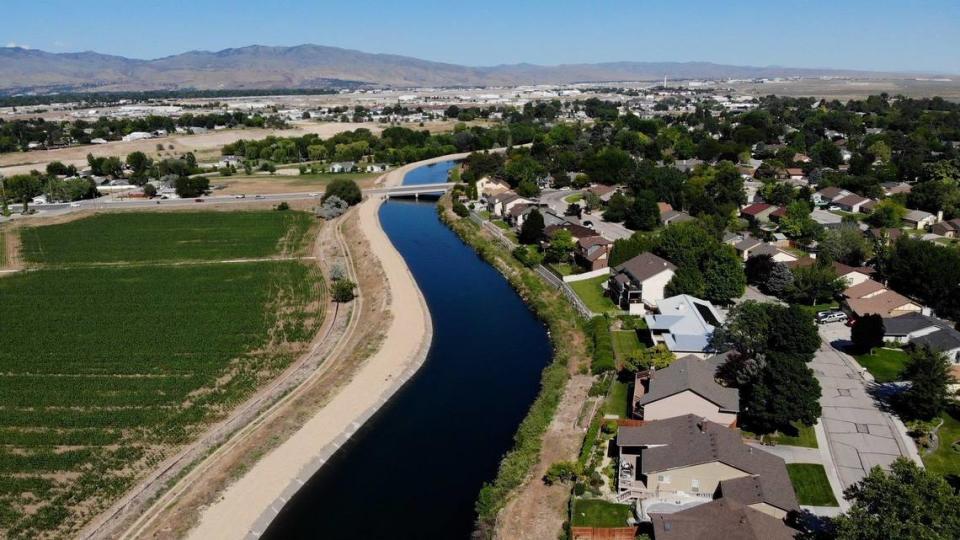
What’s the hurry? neighborhood leader asks
A City Council decision on annexation will likely be made in September, according to Tomlinson.
Marisa Keith, president of the Southwest Ada County Alliance, believes the city should slow down what she calls its current breakneck pace toward deciding on annexation and the Murgoitio land swap. She would like to see the council make greater attempts to explore different options and get a complete picture of public sentiment.
“There have been a lot of changes (in the last 15 years),” Keith said. “There have been a lot of subdivisions built up in the area of impact. I think people are more open to talking about annexation now.
“There will always be people who just don’t want to be annexed, who don’t want the higher taxes. But more people are starting to say, ‘Oh there might be benefits.’
“But we haven’t had the discussion as a community. ... We’ve never had the opportunity to say, ‘OK, how about now? How are we all feeling about this?’”
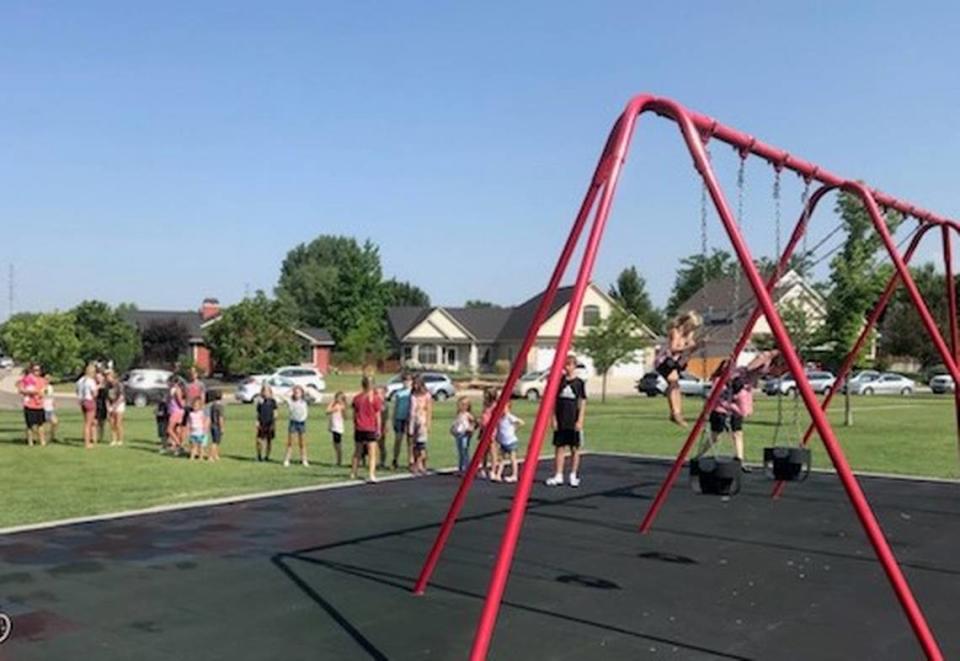
Annexation would be expensive
To annex, Tomlinson said, would be expensive.
The city would suddenly have to offer the same amenities to the area received by city residents. According to Tomlinson, that would mean adding 60 to 70 police staffers, 20 to 25 support staffers, a new fire station with additional firefighters and a fire engine, a new library, remodeling the county’s Pearl Jenson and Wrigley parks, and adding streetlights and animal services.
Former Mayor Brent Coles submitted written testimony objecting to the Murgoitio annexation. Coles wrote that the city would be putting “lives at risk” if the land was annexed before a fire station was built nearby.
That didn’t sit well with City Council member Patrick Bageant, who expressed frustration over what he considers the financial bind the city had been put in by the Coles administration. Bageant blamed Coles for making promises to the Southwest without finding a way to pay for them. Annexation, Bageant said, would provide a way to pay for a fire station.
“There was a mayoral administration 20 years ago that put us in a real situation with this park property and poor planning and poor infrastructure fees sufficient to support the promises made to the community,” Bagaent said.
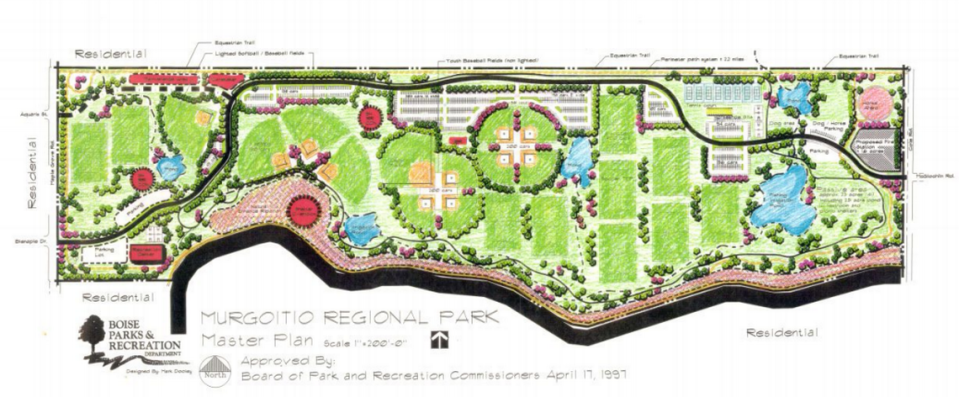
City would get little in return
Bageant was referring in part to impact fees. The cost of annexation is normally offset by impact fees. The fees are charged to builders when they apply for building permits in both the city and its area of impact. They go to services like parks, police and fire.
However, much of the area is already built out, meaning the city would receive relatively few new impact fees.
“Idaho state law is really not set up to annex already developed areas,” Elaine Clegg, the City Council president, said at the meeting. “It’s set up to annex undeveloped land and, over time, build up both the ability to provide services and the tax revenue collected to support those.”
The city received most of Southwest’s impact fees decades ago. Through an agreement with the county, the city is able to collect impact fees just for parks. Police and fire impact fees have gone to Ada County.
The Parks and Recreation Department has spent park impact money — totaling $10.5 million — on Southwest city parks Peppermint and Molenaar, as well as the larger regional parks inside city limits, since they are intended to service the entire region. Builders in the Southwest are charged lower impact fees than in the rest of the city, Tomlinson noted.
Annexation would also be expensive for residents. Tomlinson pointed out that the owner of a 1,500-square-foot home south of Victory Road, which serves as a boundary line between the city and the Southwest area, paid $1,382 in city property taxes in 2020. The owner of a home of the same size north of Victory Road, within city limits, paid $2,036.
“We’re generally looking at about a 30% to 35% impact to property owners,” Tomlinson said.
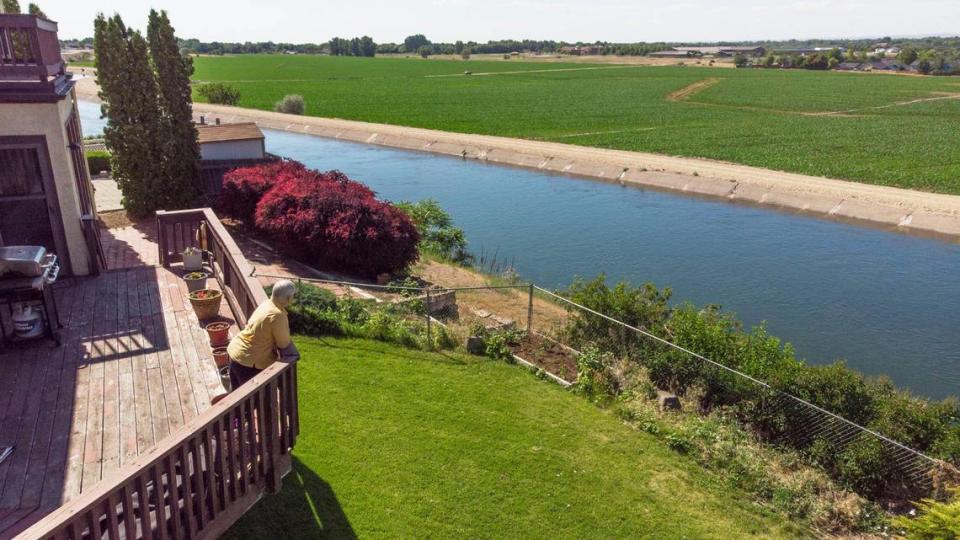
City Council will likely delay actions
The Legislature has made annexation even less attractive to the city. A new law from the 2021 legislative session means the city would receive only 90% of property taxes from new construction. That same law limits local governments to a maximum 8% increase in property taxes each year. Annexing the Southwest would mean exceeding that cap, according to Tomlinson.
The City Council presentation was the first of many steps toward a potential annexation or land swap. The next steps in the process will include removing the restrictive park covenants from the Murgoitio parcel, declaring the property as surplus (state law says property must be declared as surplus before it can be sold to the public), and annexation.
During Tuesday’s workshop, Tomlinson said that on July 20 the City Council would consider a resolution to remove the covenants and set a public hearing on the surplus declaration. However, she has since told the Statesman that those decisions will likely be delayed until she receives a broker’s opinion of value of the site.
“We need that information as a baseline to establish the surplus hearing,” Tomlinson said by email on Friday. “I am recommending to council on Tuesday that we delay the resolution removing the covenant to Aug. 17 and that on Aug. 17 we hold another work session to go over additional due diligence information and chart the course for the surplus process.”
▪ Do you support the annexation of the Southwest Boise area? Let us know in our reader survey. Or follow this link if you don’t see it below.
Sally Krutzig covers Treasure Valley growth and development. Have a story suggestion or a question? Email Krutzig at skrutzig@idahostatesman.com.
‘We’re overwhelmed’: New proposal, annexation could add thousands of homes to SW Boise
Houses, town houses, apartments by the hundreds. What’s coming to your neighborhood
Heat, drought, slim resources: Governor warns of Idaho’s worst wildfire season in years
California developer wants to tear down offices to build new student apartments

